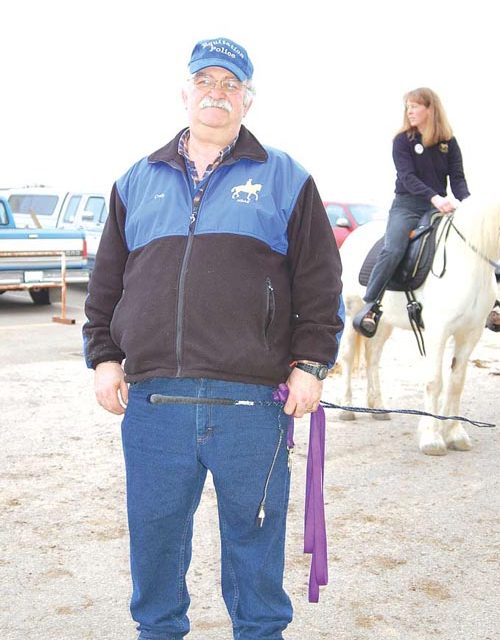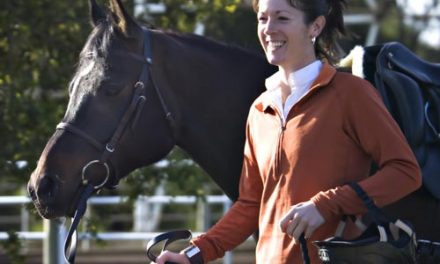We often hear something along these lines from rider, “I don’t have any interest in haute école, so why should I care about the work in hand?”
The question may come from a trail rider who can’t imagine that high school riding has any relevance to a day in the woods with their horse, or from a hunter or jumper rider who finds all dressage irritatingly slow. We also hear it from dressage riders, who want to leap to the charismatic work, so this method shows up as being boring or “less” than work in the saddle.
The difficulty, however, is one of perception. There is so much to the work in hand and, if done well, it can support and enhance any riding relationship.
The benefits of work in hand
1. It allows you to connect with your horse’s mind, not just boss around his body. Good work in hand introduces you to the horse underneath the skin—is he intelligent? Willing? Interested in people? Interested in arguing? Is he stiff? Sore? Troubled in his heart? The work in hand can function like the “small talk” that warms you up for the larger conversation of the ride. You can take a ‘weather report’ from the way your horse works, and help bring him to the riding in a much more balanced frame of mind. Most normal horses have more difficulty with the mental development, and the work in hand develops the mind of the horse, and his ability to “converse” with the rider.
2. The handler can establish a quiet, attentive, reciprocal conversation without a rider. Starting this way, the horse has much less stress when the rider does take the saddle for the first time, and the horse is physically more comfortable. The horse has worked through his balance issues before the rider adds weight to the program. He has also already begun alto move in a habitually well-balanced position. This makes the rider easier for the horse to carry and easier to respond to without fear.
3. It’s safer for the handler than riding, especially if the handler must work alone.
4. It’s an easy way to test your aids. If you’re able to get a movement from the ground, but not in the saddle, then you know you’re blocking the movement somehow with your seat or legs.
5. It allows you to find the places your horse is stiff or uncertain. Suppleness is both a mental and a physical issue, and most horses have more psychological stiffness than they do physical. A normal horse will easily do carrot stretches, or reach around and bite their rump to get rid of an itch, but the same horse may show all sorts of stiffness when asked to bend the neck for the rider. It’s most often the psychological suppling that the horse needs. Adding a reprise of work in hand anytime stiffness may have set in–such as the first thing in the morning, after trailering your horse, or when you are going to work in a new location–gives both of you time to center and supple both physically and mentally before the work begins. It’s also kinder to the animal to do the suppling without the additional weight of a rider.
6. The work in hand helps the horse come to a useful, successful posture that supports his ability to carry a rider. The riding horse has to not only physically carry the weight of the rider but also mentally accept the rider’s or trainer’s role. We have older school horses, who after a few minutes of work in hand, can be ridden repeatedly throughout the day without any stiffness or soreness. But without the gentle stretching exercises, they show their age.
7. It encourages him to cooperate and connect with you. The most valuable gift that you can give your horse is cultivating in him the desire to cooperate and be with you — not just because you give him carrots. The process of training a horse is a joy, and whether you are presenting that horse and rider relationship in a competitive arena at an international level or just heading up the hill for an afternoon together, the higher your level of connection with the horse, the better your relationship will be.The work in hand, done well, offers you a method that supports that connection throughout the rest of the work you’ll do together. We would argue that this sort of relationship is just as interesting on Saturday morning out on the Nuthatch Mountain trail as it is on a Sunday afternoon in the Grand Prix finals.
Whether you are interested in the work in hand or not might be based on what you require of the horse. What are you looking for in the relationship? If you look at the horse as a servant, what sort of servant would you prefer to have? Would you rather work with a very strong but illiterate sort of fellow with the mind of an uneducated child; fearful of monsters under the bed at night? Or would you just as soon have an educated friend with whom you can have a dialogue?
Craig Stevens is a classical instructor and trainer with the National School of Equitation, Inc. in Snohomish, Washington. For more information visit
www.classical-equitation.com.






